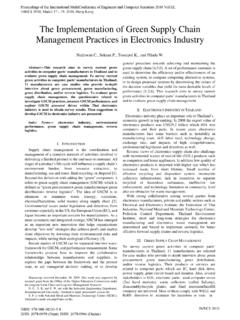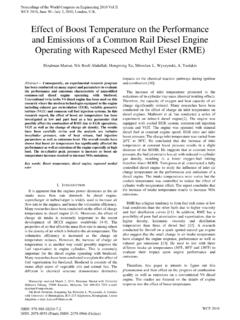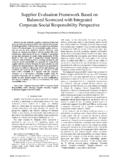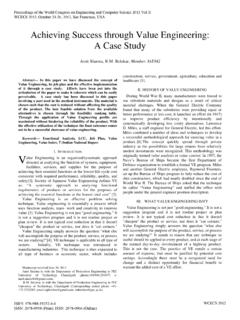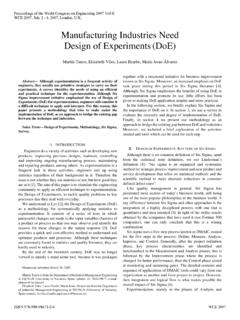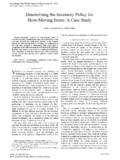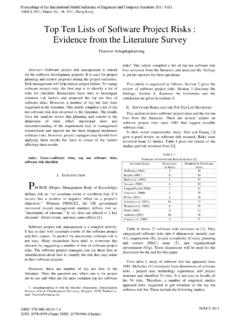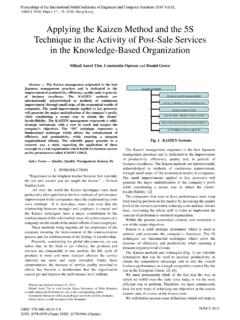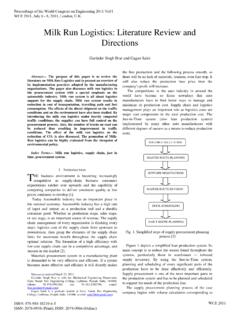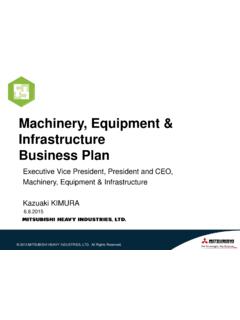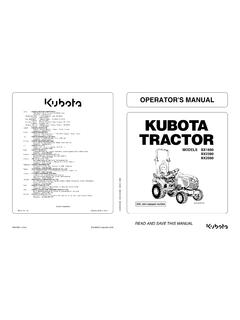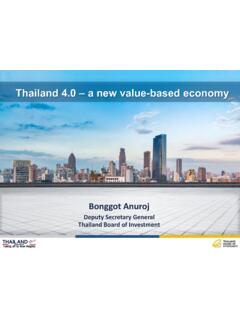Transcription of Automotive Process-based New Product Development: A …
1 Abstract The new Product development (NPD) is the process by which a new Product idea is conceived, investigated, taken through the design process, manufactured, marketed and serviced. In the Automotive industry, within the context of ISO/TS16949:2002 (the Automotive quality management system international standard), these related to the Product realization process (PRP) which consists of five phases: Plan and Define Program , Product Design and Development , Process Design and Development , Product and Process Validation , and Production Launch, Feedback Assessment and Corrective Action.
2 These phases may be done concurrently and have correlated activities. This paper proposes a Process-based management concept focusing on controlling and measuring for their effective management including literature review of NPD performance metrics. Integrating the Process-based management concept with the proper performance measure can initiate new knowledge which will contribute to the improvement of the Automotive industry. Index Terms new Product development (NPD), metrics, Process-based management, Product realization process (PRP) I.
3 INTRODUCTION The Product quality planning, which is sometimes used interchangeably with new Product development (NPD), however, the second one seemed to represent the broader term, is the process by which a new Product idea is conceived, investigated, taken through the design process, manufactured, marketed and serviced through obsolescence. Reference [23] noted that, the competitive advantage of a company can be linked to two key factors: (i) the ability to generate new intellectual property that offers superior value to customers and (ii) the ability to capitalize on it quickly.
4 Superior quality and project management optimize the performance excellence of organizations, unfortunately, the combined leverage of quality and project management is often underutilized due to inadequate related knowledge and experience, time pressures or budgetary cutbacks [29]. Reference [25] describes the quality planning road map as the activity determining customer needs and developing the products and processes required to meet those needs. The Automotive Quality Management System (QMS) International Standard, ISOTS16949:2002, the particular requirements for the application of ISO 9001:2000 [21] for Automotive production and relevant service part organizations, defined Product Realization Process (PRP) Komsan Sanongpong is with Assumption University of thailand (e-mail: as one of major parts of the standard, a useful framework for understanding the Product quality planning in general.)
5 Reference [7] defined the methodology for managing new Product development, Advance Product Quality Planning (APQP), in the Automotive supply chains. ISO/TS16949:2002 determines this as one of the means to achieve the PRP (NPD) s objectives. Since it is published, the APQP play an important role in the Automotive industry worldwide, especially in thailand , as it appeared to be significantly practical to the NPD team. In other words, implementing the PRP without more specific methodology like APQP, especially for the local companies in thailand , result in less competitiveness to the market.
6 The APQP embodies the concepts of error prevention and continual improvement in contrasted to error detection, and is based on a multidisciplinary approach. The APQP consists of five phases as follows (see Fig. 1): Phase 1 - Plan & Define Program. Phase 2 - Product Design and Development. Phase 3 - Process Design and Development. Phase 4 - Product and Process Validation. Phase 5 - Production Launch, Feedback Assessment and Corrective Action. In real practice, these phases may overlap and many tasks are done in parallel (concurrent engineering) to streamline and maximize resource utilization.
7 Fig. 2 describes the rationale how customer requirements are deployed and communicated to all levels of the organization in the PRP (NPD). The purpose of this paper is to set the scope and conduct literature review for further study under Process-based New Product Development Performance on the Automotive Industry in thailand , it also sought to determine the need for performance measurement during the NPD process and reveal which measures are Fig. 1 APQP Phases (AIAG, 1995) Automotive Process-based New Product Development: A Review of Key Performance Metrics Komsan Sanongpong Proceedings of the World Congress on Engineering 2009 Vol IWCE 2009, July 1 - 3, 2009, London, : 978-988-17012-5-1 WCE 2009 currently used, which further measures are needed and where improvements can be made, based on Automotive Process-based management proposed by the author.
8 II. MANAGING THE Process-based NPD Ones of the most important keys of success of NPD are interest, commitment and support of management. Reference [5] described the preferred characteristics of NPD which is developing under the direction of top management. Reference [12] defined the NPD significant characteristics which are repeatable to effectively communicate to team with consistent use of the defined process and flexible to tailor to the different needs. The most important task in improving the development program is improving the communication between the development team and the management [8].
9 Since NPD are based on information content and their accompanying information-dominated methods, an efficient methodology for reducing NPD time initially requires developing an understanding of information flow among different project processes [1]. The trend in organizational structures for high performance Product development organizations has moved toward integrated models [13], [31], support by cross functional teams that know how to manage their knowledge and communication boundaries effectively [2]-[3], [4].
10 Benefit from applied research are greatest when the NPD process is closely integrated with the operations of a firm and motivated by the problems and opportunities it faces, this integration can enable a superior Product development process overall, if the limiting factors it introduces are addressed successfully [23]. The study of the effect of Transaction Memory System (TMS) on NPD outcomes including mediating and moderating factors, the collective mind and environment turbulence, respectively found that: 1) TMS has positive impact on team learning and speed-to-market; 2) the collective mind ( team members attention to interrelating actions) mediates relations between the TMS, team learning, and speed-to-market; and 3) team learning and speed-to-market mediates relations between the TMS and new Product success [6].
